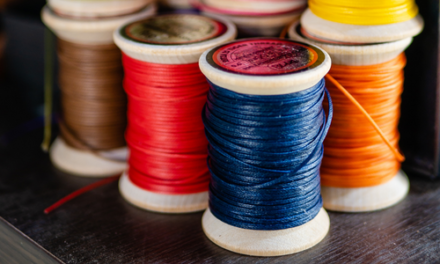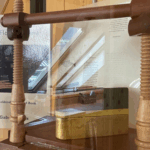In my opinion, Coptic bindings are a great way for new binders to move from pamphlets and accordion bindings (or similar) to something more substantial. Since Coptics have an exposed spine, the covers are sewn to the book block directly. Because of this, thread choice is really important to support the spine. So, what is the best thread for coptic bindings?
In today’s post, I’m going to share what has worked best for me. Take these as recommendations and feel free to expand in your own way. The fun of bookbinding is learning how to take the structure and truly “make it your own.” Let’s get into it!
Why thread matters for Coptics
I love Coptics. They’re beautiful to look at, offer a lot of creative potential and lay flat for personal journals, sketch books and more. The only downside of a Coptic is the exposed spine. Books with a covered spine have all kinds of additional materials to reinforce the spine (adhesive, tighter thread weaves, mull, etc.), but Coptics only have thread. We just need to remember this and choose a thread that is strong enough to last through frequent use.
Best thread for Coptic bindings
I’m going to cut right to the chase. In all my years of making books, I’ve found one thread to be the best thread for Coptic bindings: Crawford’s 3-ply and 2-ply waxed linen thread.

I chose this thread for a few reasons:
- 3-ply and 2-ply thickness will work for a lot of common book sizes
- High quality and tensile strength
- Tons of available colors

I’ve tried all of Crawford’s waxed threads up to 7-ply thickness. The 3-ply is hands-down the most versatile. Some thicker threads can be hard to sew, creating a bulky stitch. This is a bummer because it can be hard to see the pattern or design. With a 3-ply waxed thread, the design pops through immediately while still providing the book with adequate support.
Where can I buy Crawford thread?
Crawford thread is on the pricier side, but totally worth it.
When I first decided to try Crawford, I didn’t want to spend a lot of money. I went on Etsy and found a lovely seller in the United States who offered every color of Crawford 3-ply (and many other ply) in 5-yard increments. I purchased a full color set in 3-ply thickness for around $65 plus tax and shipping. While this sounds like a lot, it’s really not… Every Crawford roll costs around $15 or more each. I definitely wanted to see and work with the thread before investing in a set. I made a lot of Coptics from that one set of thread!
Today, I buy my Crawford thread wholesale from a company called Royalwood Limited. Their website is straight out of 1997, but trust me… they do a great job. Just FYI, for all wholesale orders, you must spend at least $100.
Can I use a 2-ply thread instead?
Yes, absolutely. The difference between 2- and 3-ply thread is minimal. Crawford’s waxed 3-ply linen thread is roughly 0.6 mm in total thickness due to the small amount of wax added to each thread and waxed 2-ply is about 0.5 mm.
When making books, I noticed a stronger hold with less tension when using Crawford’s 3-ply thread. As the books get bigger, so will my thread gauge. For a 10×8″ book, I used 4-ply.
Here are a few of Crawford’s waxed threads by ply to show you the difference:

Thread tension
Previously, I mentioned tension. Tension is the strength used to tighten a stitch while sewing. Sewing a book with too much tension in the thread will make it hard to open. Too little tension and the book will flop open like a fish on deck.
As with all other bindings, Coptics need the right amount of tension on the thread to add support and strength while still allowing the book to open easily. Thread ply and tension go hand-in-hand. Thicker threads will add more support while allowing less tension. The reverse is true for thinner threads. When I work with a 2-ply thread, I’m always careful to add just a wee bit more tension to each stitch for added support.
This process is a lot easier said than done. It took me about a dozen Coptics to get a good feel for tension across different types of threads and book sizes. Go easy on yourself and keep practicing until you get it right!
Book size matters…a little
Signatures and paper thickness can both have an impact on how well the stitch design stands out. To demonstrate this, I used the 3-ply thread on both books shown below. The smaller book is 3×2″. Notice how the thread looks a little bulky and the braid is harder to see. This happened because I was working with a thinner paper and fewer signatures while still using the 3-ply thread.
The second book is 9×6″ with double the signatures and a slightly heavier paper. The thread thickness is the same (3-ply), but the volume of the signatures allows each braid to come through better.
Both of these books were beloved by their new owner. She didn’t even see the difference my trained eye picked up, so believe me when I say book size matters…but just a little!

Be creative & have fun!
Remember… this is bookbinding. You don’t have to be a stickler about these things, but I hope my advice has helped you in some way to make a better decision. Below are some more resources that might help you on your way.
More bookbinding goodness
✨ What tools do I need to get started bookbinding?
- Bookbinding Tools & Supplies Quick Start Guide – learn all about book making tools, which to buy first & where to go online
- Pick up my popular Complete Starter Bookbinding Tools Kit – all the bookbinding essentials in one spot
🌟 Looking for a simple way to start making books?
Try a Complete Book Materials Kit. Each one has everything you need (+ tutorials & videos) to make a beautiful book without all the fuss.
Thank you for taking me along on your book making journey!
Misty











